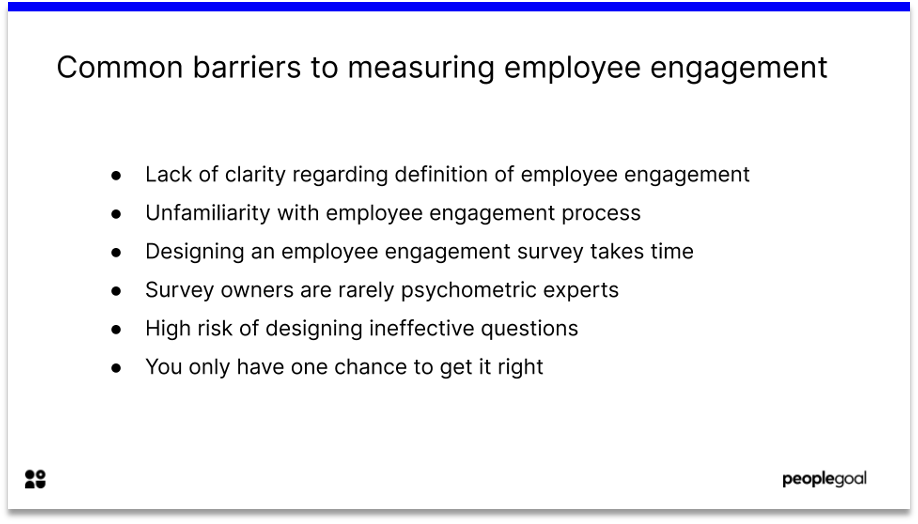Companies need to improve employee engagement
One of the key HR trends for 2021 is improving employee engagement. The success of any organization is reliant on the output of its workers, and organizations that are capable of engaging and motivating their employees will see the best results. For example, Gallup recorded that highly engaged teams achieve 21% higher profitability. However, many companies struggle to measure employee engagement the right way.
To succeed in today’s highly competitive business environment, companies need an engaged, motivated and proactive team of employees who are passionate about the business outcomes organizational success. This article will give you some guidance on benchmarking engagement survey metrics, which will help you measure employee engagement more effectively within your organization.

Measuring employee engagement can be difficult
The most significant challenge to measuring employee engagement is the lack of a set definition as to what is it.
Is engagement about being happy at work? Is it about being productive? Is it about doing work that is meaningful to you personally? Or perhaps all of the above?
The question is difficult to answer because each organization uses different definitions of engagement, dependant on their unique company culture. It is important to establish a clear definition before you establish your benchmark metrics.

Common barriers to measuring employee engagement:
- Lack of clarity regarding definition of employee engagement
- Unfamiliarity with employee engagement process
- Designing an employee engagement survey takes time
- Survey owners are rarely psychometric experts
- High risk of designing ineffective questions
- You only have one chance to get it right
Employee engagement metrics
There are a wide range of ways to measure how engaged your employees are. Take a look at the list below:

- Annual engagement surveys
- Pulse surveys
- Exit interviews
- Employee turnover/retention rate
- Absenteeism
- Vacation Days Used
- Customer satisfaction
- New hire failure rate
The best approaches are the proactive ones that identify problems before employees want to leave and that provide concrete data, like annual engagement and pulse surveys. But what exactly should employee surveys measure, and how should they measure it?
There are a variety of ways to gather employee feedback that will help you track improvements in employee engagement. The most common metric used to measure employee engagement is the Likert Scale, typically a 5 point scale which measures satisfaction from strongly agree to strongly disagree. Other methods are calculating an eNPS (employee net promoter score) which indicates employee loyalty, or a more contemporary approach like measuring happiness with a traffic light survey.
Ways to measure employee engagement:
- Likert scale
- eNPS (Employee Net Promoter Score
- Traffic light survey
Find out more about employee enagement survey best practices in this article.
What are benchmark metrics and why are they important
Benchmarking engagement metrics involves comparing your survey results with the another organization. It can also mean internally benchmarking your engagement data against historic data.
Interpreting survey results without anything to score them against is a pointless exercise, because you will not know if your results are good or bad. Benchmark reports are so important for understanding survey data because they provide context and meaning for interpreting scores.
Establishing benchmarks for your employee engagement survey will enable you to kick off your process in the right way, addressing the areas that need the biggest improvement first. It will also help you better understand how your employee engagement is tracking over time.
Three different types of HR benchmarking metrics to help you kick off your engagement survey

Historical data
Benchmark comparisons to data from previous surveys, if you have access that information. This will allow you to keep track of progress and identify where improvements have been made, and where progress has stalled. A key element of employee engagement surveys is to drive improvement, therefore comparisons with old data will measure an organization’s progress towards its goals.
External data
It is good practice for leaders to look for insight into how their engagement process compares to other organizations. These benchmark comparisons can provide context for what is normal or average across survey items and results. This is especially important where there is no historical data to compare to.
Using tried and tested employee engagement tools, such as the Gallup Q12 survey, will allow you to draw upon a large database of comparative data that can be used to benchmark your employee engagement against similar organizations. However, this trusted tool naturally comes with a hefty price tag.
Internal data
Alternatively, you can develop your own, bespoke employee engagement survey which includes organization-specific questions that measure the most important elements of employee engagement within your organziation. Whilst this approach is clearly advantageous to your business, it is not possible to accurately benchmark against other organizations.
Considerations when using benchmarks to plan your engagement survey
Standardize your survey design
In order to establish a successful engagement survey there are a few things you need to bear in mind. It is essential that the survey questions are consistent. If the survey questions change every year, there will be no way to compare answers to previous years.
Benchmarking should be balanced with the strategic priorities and insights needed by organization leaders. Multiple choice, ranked lists and open-ended questions should be balanced with the the Likert (five-point "strongly agree" to "strongly disagree") scale.
If you’re using a vendor to run the survey (bonus points if they support fully customizable and automated surveys), make sure they tailor the survey to your specific requirements.
Don’t get bogged down by benchmarks
Yes they are important and will help you identify areas of strength and weakness, but they don’t provide you with insight of which areas are most important for planning. Many leaders become focused on the area scoring lowest below the benchmark, however it might not be the area that needs the most improvement for driving overall engagement. Instead, focus on the key drivers of engagement and address those key barriers.
Likewise, don’t equate satisfying the benchmark with success. Just because one area is consistently hitting its benchmark does not mean it is perfect. Keep the focus on driving change and on improving behaviour that the benchmark score represents.
10 key metrics you should use to benchmark your employee engagement survey

There is much debate on what exactly an employee engagement survey should measure. At the end of the day, it is up to your organization to decide how engagement should be measured and what factors should drive it. To get you started, we have compiled a list of the key engagement metrics we think you should measure in your survey:
1. Sense of meaning and purpose
2. Good understanding of organizational strategy and company culture
3. High level of autonomy
4. Positive and supportive employee-manager relationships
5. Opportunity for personal and professional growth
6. Good relationships with colleagues
7. Pride in and commitment to the organization
8. Sense of accomplishment
9. Recognition for good work
10. Good personal health and physical and mental wellbeing
Next steps
If you are still unsure how to create your first employee engagement survey read our guide to employee engagement surveys and make your company a great place to work.
Ready to look inside the box? We’re here to help. Schedule a demo with PeopleGoal this week to find how you can get a free survey to use with your company.
Ready to 3x Your Teams' Performance?
Use the best performance management software to align goals, track progress, and boost employee engagement.


![What Is Employee Performance Management? [Tips to 3x Productivity]](https://www.peoplegoal.com/blog/wp-content/uploads/2019/08/What-Is-Employee-Performance-Management_.png)


